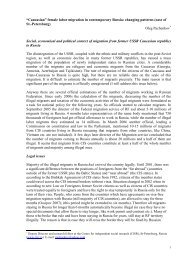THORIUM AS AN ENERGY SOURCE - Opportunities for Norway ...
THORIUM AS AN ENERGY SOURCE - Opportunities for Norway ...
THORIUM AS AN ENERGY SOURCE - Opportunities for Norway ...
You also want an ePaper? Increase the reach of your titles
YUMPU automatically turns print PDFs into web optimized ePapers that Google loves.
The Back End of the Thorium Fuel Cycle<br />
substance is dissolved in nitric acid and separated by solvent extraction. Thorium is considerably<br />
less amenable than uranium to such processing.<br />
Reprocessing difficulties are especially severe with HTR-type fuels of whatever composition, since<br />
the particle coatings and graphite matrix are chemically resistant and troublesome to break down<br />
mechanically.<br />
6.3.1 The “Head-End” Operations<br />
The aim of these operations is to obtain, after preliminary operations leading to dissolution, a<br />
solution of U-Th nitrates together with a small quantity of minor actinides and fission products.<br />
Extraction of U-233 from irradiated thorium rods was conducted extensively in the US from the<br />
1950s until the 1970s. Almost 700 tonnes thorium were irradiated, delivering more than 1.5<br />
tonnes of U-233. The separation operations were piloted at ORNL in the THOREX plant, and in<br />
the Knolls Atomic Power Laboratory. The process was later adapted to the Great “canyon” plants<br />
at Han<strong>for</strong>d and Savannah River (SRP), and the commercial direct maintenance plant of Nuclear<br />
Fuel Services at West Valley near Buffalo, now being dismantled, which reprocessed the first core<br />
of Indian Point 1 (95% ThO2, 5% U-235O2), but without recovering thorium (which was left in the<br />
waste).<br />
The processes are explained in an interesting paper [146], which is one of the early documents<br />
giving details of the processes and of the adaptation of these large PUREX-type plants to the<br />
THOREX processes (Figure 6.3).<br />
Figure 6.3: Outline of the THOREX Process (Thorium Extraction).<br />
Head-end operations <strong>for</strong> fertile fuels to extract U-233: Due to its great stability, dissolution of<br />
thorium or ThO2 is not as straight<strong>for</strong>ward as that of U, and especially of UO2. Strong nitric acid<br />
with HF is required, and the process takes a rather long time, especially <strong>for</strong> high temperature<br />
sintered compact ThO2. Dissolution can take up to 35 hours. To prevent corrosion of the<br />
equipment by HF, aluminium nitrate was added as a buffer.<br />
Similar processes have been used in India on a small scale <strong>for</strong> thorium and ThO2 rods and in<br />
other countries (UK at Dounray, Canada at Whiteshell, Germany at Jülich and Karlsruhe). In<br />
75

















